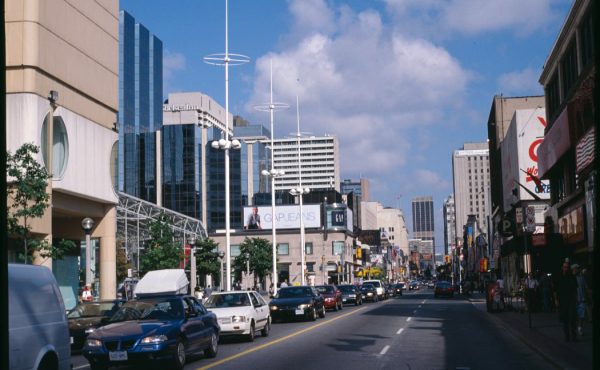Editor’s note: This is the fourth post in a series that investigates the emerging concept of the Naturally Occurring Cultural District (NOCD). Posts will explore the ways in which the NOCD concept could be applied to specific areas in Toronto to inform more equitable, localized forms of cultural planning.
![]()
The past decade of cultural investment in Toronto has been monumental, both in scale and purpose, exemplified by Gehry’s AGO, Libeskind’s ROM, and many more. The City’s prioritization of downtown cultural institutions was unprecedented and is said to have resulted in thousands of visitors to the city, hundreds of jobs, and millions of dollars of subsequent investment.
We are now in a period of post-Cultural Renaissance and a key question is how to shift the focus towards local, community-based cultural activities in Toronto. How can the city use deliberate policy-making and planning efforts to support a full range of cultural activities in a non-hierarchical fashion? And how can we ensure that these efforts support the space and funding needs of existing small arts organizations, without impeding their natural developmental direction?
The City of Toronto’s Cultural Services has undertaken a public consultation process to address these issues head-on. The pilot project, titled Making Space for Culture, aims to take inventory of local cultural activities and analyze cultural facility needs at the neighbourhood level. Through ward-by-ward consultations and analysis, the project’s goal is to enhance neighbourhood cultural space and ensure more equitable access to the arts — through both production and consumption — for all Torontonians.
Making Space is a direct response to the absence of investment in the development and upgrading of facilities for small cultural organizations, programs, and social enterprises in the City’s last wave of cultural infrastructure investment. Toronto’s most recent culture plan report, Creative Capital Gains: An Action Plan for Toronto, identifies the next priorities in terms of cultural planning efforts, demonstrating a clear shift towards small-scale, neighbourhood level cultural activities. Creative Capital Gains recommends that the City works to “ensure a supply of affordable, sustainable cultural space”, “ensure access and opportunity for cultural participation to all citizens”, and “support the development of creative clusters and emerging cultural scenes”. These three recommendations link to many of the themes present in the Naturally Occurring Cultural District concept (explored in previous posts of this series), and necessitated the launch of the Making Space for Culture project.
Sally Han, Senior Cultural Affairs Officer with the City of Toronto, said that Making Space for Culture grew out of these recommendations and the need to examine infrastructure investment potential at the neighbourhood level, combined with political pressure to ensure that the suburbs were benefiting from the City’s cultural investments.
“The key thing that everyone must understand is that, before amalgamation, the old City of Toronto made investments in public infrastructure in a way that the suburbs did not. The suburbs don’t have the same legacy to draw on. We are trying to mitigate that reality and move towards a more equitable distribution,” said Han.
The project uses ward-specific public consultations to gain a better understanding of how residents are engaging with culture in their neighbourhoods. Once this information is collected, the City can have a better sense of what possibilities exist for long-term investment in creating and sustaining affordable space for cultural industries and community arts.
Recognizing that massive cultural infrastructure investment is currently unrealistic, the City is now focusing on maximizing the potential of existing spaces, including libraries, community centers, and parks. By looking at the existing real estate portfolio through a cultural lens, opportunities to support existing cultural activities throughout the city may become apparent. Protection of industrial and commercial spaces for cultural use through the City’s Official Plan, site-specific re-zoning, Section 37 funding for projects by city councillors, and targeted funding for capital repairs in non-City-owned cultural facilities are all considered realistic options.
With funding from the Ministry of Culture, Making Space for Culture is set to complete 20 ward consultations by October. The wards selected for study were chosen using the Cultural Location Index (first developed in the 2011 report From the Ground Up) to represent a wide variety of types and degrees of cultural engagement and infrastructure. By March 2013, the Making Space team hopes to have maps and data of wards that are very different from one another and a realistic sense of what kinds of infrastructure and investment are needed across the city.
“In some wards, there is low participation and low interest. But there are surprising pockets of activity, involvement, and entrepreneurialism, which represent potential places for investment and infrastructure,” said Han. The consultation undertaken in Ward 10, York Center, for example, revealed a great interest in social entrepreneurialism through cultural activities by Russian Jewish and new Philippine immigrants. This is exactly the kind of data that Making Space is searching for, and could guide the development of “mini Culture Plans” for these neighbourhoods.
Making Space for Culture is ultimately educating Torontonians — residents, city councillors, artists, and social entrepreneurs — on the importance of investment in cultural infrastructure at the active participant level. By taking the “cultural pulse” of wards throughout the City, the project seeks to better understand the facility, funding, and infrastructure needs of existing neighbourhood-based cultural activities and to respond to these needs with supportive, sustainable solutions. It makes space for culture, rather than making culture. It understands the importance of cultural activity to local social networks and economies, while situating this understanding in a context of equitable and sustainable development. Making Space for Culture is a project that supports, rather than dictates, the natural development of place-based cultural activities in Toronto.
Photos courtesy of The City of Toronto’s Cultural Services.






One comment
It took me a little while to figure out what cultural space was being pointed at in the first picture, since it’s in the middle of nowhere, Scarborough — more specifically, a short walk from where I live. He’s pointing out the location of the Taste of Lawrence.